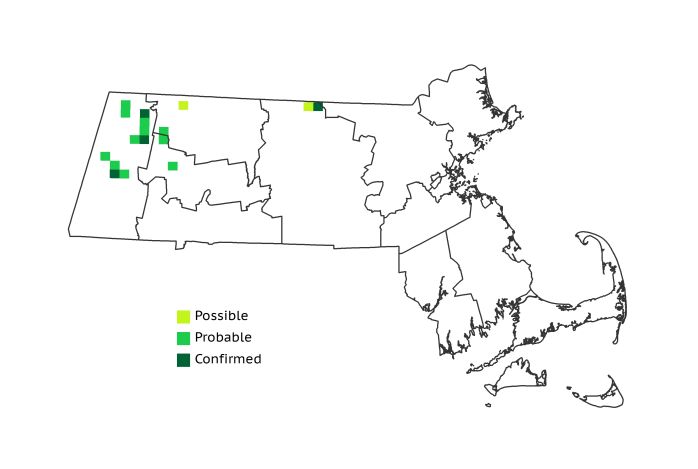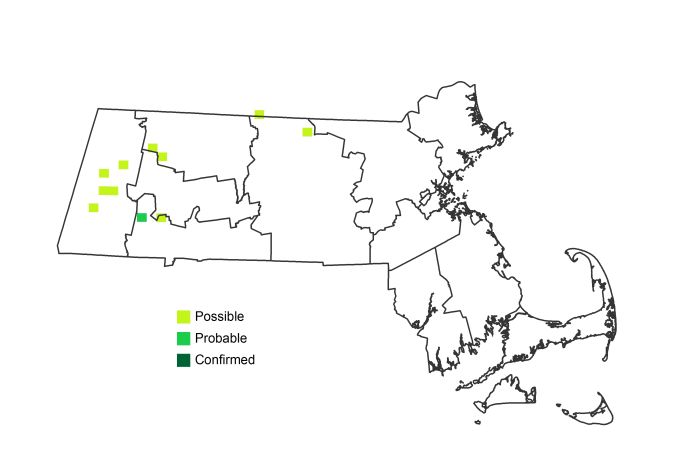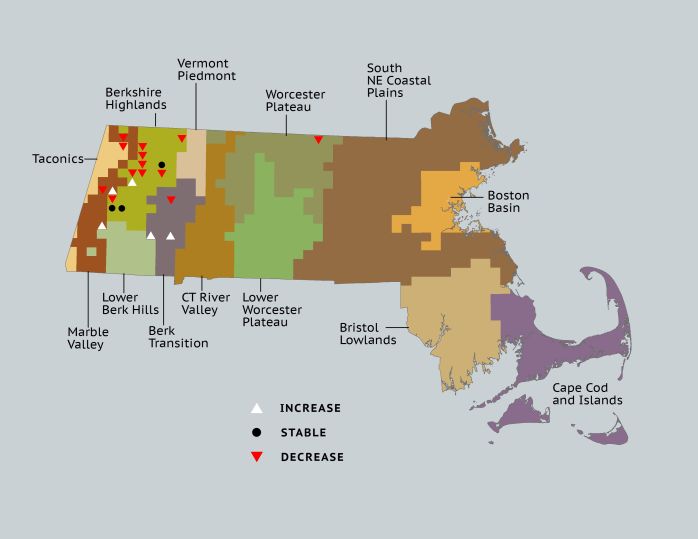Find a Bird
Olive-sided Flycatcher
Contopus cooperi

Very local and strongly declining
Conservation action urgent
“Our recluse is pugnacious; his mate is company enough, and he defends an exclusive territory against any interloping male of the same species.” Edward Howe Forbush, Birds of Massachusetts and Other New England States
Olive-sided Flycatchers are rare breeders in Massachusetts, and areas where they can be found are reminiscent of the boreal swamps far to our north. The males sing and hawk insects from conspicuous perches in tall snags, and their three-note song (hip-THREE-cheers, or quick-THREE-beers if you prefer) is distinctive. Boreal spruce bogs with some dead standing wood are the preferred habitat of Olive-sided Flycatchers, and there are only a few places in the Bay State today where they may be reliably encountered.
Historic Status
The Olive-sided Flycatcher once had a wide breeding distribution in the state, and it is one of the species in the state with the most reduced breeding footprint. In 1830, both Thomas Nuttall (Cambridge) and John James Audubon (Brookline) found nesting Olive-sided Flycatchers in eastern Massachusetts (Howe & Allen 1901), a phenomenon nearly inconceivable to us today. Nuttall, in fact, named the species, and for a time it carried the Linnaean name Nuttallornis borealis. By 1858, the species was found breeding in Lynn, and it continued to nest, if only irregularly, in the Boston area until the 1870s (Howe & Allen 1901). Thereafter, it rapidly vanished from the region, retreating to the pine barrens of Plymouth and Barnstable Counties and the higher hills in the western half of the state (Howe & Allen 1901). Soon, it abandoned the southeastern corner, and shortly after the beginning of the twentieth century almost exclusively confined itself to areas west of the Connecticut River (Forbush 1927). William Brewster opined that “the birds which formerly bred in eastern Massachusetts represented an overflow from other and more congenial summer haunts to which they have since returned” (Brewster 1906).
Atlas 1 Distribution
Boreal spruce bogs have always been a rare habitat type in Massachusetts, but Olive-sided Flycatchers still persisted at a handful of breeding localities in Atlas 1. The Taconic Mountains and Marble Valleys had several occupied blocks, but the Berkshire Highlands region was the center of the Olive-sided Flycatcher’s thin Massachusetts distribution. More than half of all breeding records came from this region’s high-altitude wetlands. The only other place in the Commonwealth where breeding Olive-sided Flycatchers were found was Mount Watatic at the northern edge of the Worcester Plateau.
Atlas 2 Distribution and Change
Olive-sided Flycatchers moved further toward extirpation in Massachusetts by Atlas 2. Not a single Confirmed instance of breeding was reported anywhere in the state, and the only Probable report came from the Berkshire Transition, where there had been no breeding evidence in Atlas 1. The Berkshire Highlands were still host to more Olive-sided Flycatcher sightings than any other region, but, where it was formerly present in 11 blocks, it was this time recorded in only 5.
Atlas 1 Map

Atlas 2 Map

Atlas Change Map

Ecoregion Data
Atlas 1 | Atlas 2 | Change | ||||||
Ecoregion | # Blocks | % Blocks | % of Range | # Blocks | % Blocks | % of Range | Change in # Blocks | Change in % Blocks |
Taconic Mountains | 1 | 6.3 | 5.9 | 0 | 0.0 | 0.0 | -1 | -6.7 |
Marble Valleys/Housatonic Valley | 2 | 5.1 | 11.8 | 2 | 5.1 | 18.2 | 0 | 0.0 |
Berkshire Highlands | 11 | 20.0 | 64.7 | 5 | 9.1 | 45.5 | -7 | -13.2 |
Lower Berkshire Hills | 0 | 0.0 | 0.0 | 0 | 0.0 | 0.0 | 0 | 0.0 |
Vermont Piedmont | 0 | 0.0 | 0.0 | 0 | 0.0 | 0.0 | 0 | 0.0 |
Berkshire Transition | 1 | 2.6 | 5.9 | 2 | 5.0 | 18.2 | 1 | 3.2 |
Connecticut River Valley | 0 | 0.0 | 0.0 | 0 | 0.0 | 0.0 | 0 | 0.0 |
Worcester Plateau | 2 | 2.6 | 11.8 | 2 | 2.3 | 18.2 | -1 | -2.1 |
Lower Worcester Plateau | 0 | 0.0 | 0.0 | 0 | 0.0 | 0.0 | 0 | 0.0 |
S. New England Coastal Plains and Hills | 0 | 0.0 | 0.0 | 0 | 0.0 | 0.0 | 0 | 0.0 |
Boston Basin | 0 | 0.0 | 0.0 | 0 | 0.0 | 0.0 | 0 | 0.0 |
Bristol and Narragansett Lowlands | 0 | 0.0 | 0.0 | 0 | 0.0 | 0.0 | 0 | 0.0 |
Cape Cod and Islands | 0 | 0.0 | 0.0 | 0 | 0.0 | 0.0 | 0 | 0.0 |
Statewide Total | 17 | 1.8 | 100.0 | 11 | 1.1 | 100.0 | -8 | -1.0 |
Notes
The Olive-sided Flycatcher shows a significant decreasing Breeding Bird Survey trend in the Eastern US overall.



